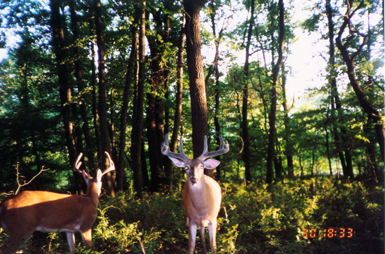
Population estimation of white-tailed deer is an important cornerstone for the development of deer management strategies. However, estimating deer populations in heavily forested regions is difficult because of reduced visibility. Traditional survey methods, including spotlight counts and aerial surveys, provide limited results in dense forests. So now what?
The use of game cameras, or trail cameras, can provide photo records of an individual deer, a deer herd, and important parameters such as population estimates, sex ratios, and productivity. In an attempt to estimate a deer herd using game cameras, a census project was carried out in 2004 in the piney woods of east Texas, on a property 1,002-acres in size. A total of 7 cameras were placed out (1 trail camera per 150-acres) from September 2 to September 12.
A total of 158 photographs of deer were taken during that time. Twenty-three buck, 97 doe, and 48 fawn photos were collected/observed. Of the 23 total buck observations, 15 individual bucks were identified. The buck to doe ratio was calculated to be 1 buck:4.2 does (23 bucks:97 does). Since 15 individual buck photos were taken, 15 was multiplied by 4.2 to give a doe population size of 63 animals.
The doe to fawn ratio was 1 doe:0.50 fawns (97 does:0.49 fawns). The doe herd of 63 was multiped by 0.49 to put the number of fawns at 31 animals. Using the data/photos collected from the 7 game cameras, the total population of the 1,002-acre ranch was estimated to be 15 bucks, 63 does, and 31 fawns, for a total of 109 animals and a density of 1 deer/9.2 acres.
Their results concluded that buck-to-doe ratios were skewed, the fawn crop for that year was higher than average, and the deer density was above average. If this data is accurate, then recommendations should include continued doe harvest while limiting buck harvest to only mature bucks, if improving sex ratio and buck quality are a goals.
Their photos showed that most bucks photographed were 1 1/2 to 2 1/2 years old. Obviously, protecting these young animals will increase the number of mature bucks, improve sex ratio, and increase buck antler quality.
My Two Cents:
I think game cameras do have a place in deer surveys. However, there are a few problems with this particular study. First, the study takes place on an unknown population of deer. Granted, it’s very difficult to get an exact deer density, but I would like to have seen other population estimates based on the other survey methods mentioned previously.
In addtion, there is likely bias towards under-estimating doe and fawn numbers. Fall surveys under-estimate their numbers because of their smaller home range sizes. In addition, bucks tend to dominate limited food sources because of their larger body size.
Regardless, game cameras do provide valuable information on buck age structure, the progression of individual bucks over time, good estimates of fawn production, and provide trend data to monitor a deer herd over time.
Game cameras work really well when used properly. We’ve used them for about 5 years now and our deer population is right where we want it as far a buck to doe ratio and age structure in bucks. Helps us ID culls. Cameras are great tools!
Great article. Thinking about getting a motion triggered camera to check out the deer on our hunting property. Would also use them to survey the deer population to estimate total numbers. How long do the batteries work in these types of trail cameras?